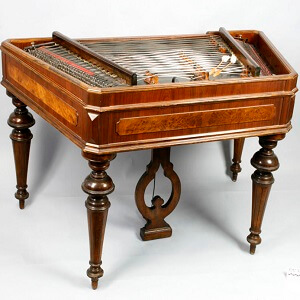Cimbalom
 The cimbalom is a hammered dulcimer from Central-Eastern Europe, particularly Hungary. About 125 steel and copper strings are stretched across a trapezoidal box and struck by two beaters, producing treble or bass tones. The instrument stands on four legs and has a dampening pedal. Cimbalom beaters curve upward and are wrapped in either soft or hard leather for desired timbre.
The cimbalom is a hammered dulcimer from Central-Eastern Europe, particularly Hungary. About 125 steel and copper strings are stretched across a trapezoidal box and struck by two beaters, producing treble or bass tones. The instrument stands on four legs and has a dampening pedal. Cimbalom beaters curve upward and are wrapped in either soft or hard leather for desired timbre.
The cimbalom was invented by Jozsef Schunda in 1870. The instrument gained popularity in Budapest and was eventually named the national instrument of Hungary. A smaller, portable version of the cimbalom can be attached to its player’s shoulders.
Variations of the instrument are rooted in other countries, from Romania and Greece to Poland and Latvia. Gypsies commonly used portable versions strapped across their shoulders for entertaining in the streets.
The elaborate, table-like instrument has a trapezoidal shape and stands on four legs, its player sitting poised behind it. About 125 strings stretch across the top, with three to five strings per note.